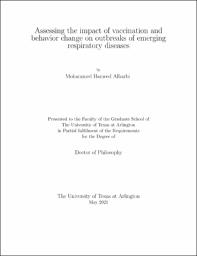
ATTENTION: The works hosted here are being migrated to a new repository that will consolidate resources, improve discoverability, and better show UTA's research impact on the global community. We will update authors as the migration progresses. Please see MavMatrix for more information.
Show simple item record
| dc.contributor.advisor | Kribs, Christopher | |
| dc.creator | Alharbi, Mohammed Hameed | |
| dc.date.accessioned | 2021-05-28T20:50:51Z | |
| dc.date.available | 2021-05-28T20:50:51Z | |
| dc.date.created | 2021-05 | |
| dc.date.issued | 2021-05-03 | |
| dc.date.submitted | May 2021 | |
| dc.identifier.uri | http://hdl.handle.net/10106/29761 | |
| dc.description.abstract | The purpose of this dissertation is to use mathematical models to evaluate the impact of characteristics of respiratory diseases like influenza and COVID-19 either alone or co-circulating and how might influenza vaccine affect this interplay. First, we assess the effects of matching and mismatching between vaccine strains and circulating strains during the Hajj. Then we evaluate the impact of the proportion of asymptomatic COVID- 19 infections on the magnitude of an epidemic under three different behavior change scenarios. Finally, we model the co-circulation of influenza and COVID-19 to investigate whether the influenza vaccine increases the combined disease burden of influenza and COVID-19 in a dual epidemic.
The influenza virus causes severe respiratory illnesses and deaths worldwide every year. It spreads quickly in an overcrowded area like the annual Hajj pilgrimage in Saudi Arabia. Vaccination is the primary strategy for protection against influenza. Due to the occurrence of antigenic shift and drift of the influenza virus, a mismatch between vaccine strains and circulating strains of influenza may occur. We study the impact of mismatch between vaccine strains and circulating strains during Hajj, which brings together individuals from all over the globe. We develop deterministic mathematical models of influenza with different populations and strains from the Northern and Southern hemispheres. Results show that the existence and duration of an influenza outbreak during Hajj depend on vaccine efficacy. In this concern, we discuss four scenarios: vaccine strains for both groups match/mismatch circulating strains, and vaccine strains match their target strains and mismatch the other strains. Further, a scenario where a novel pandemic strain arises. Results show that as long as the influenza vaccines match their target strains, there will be no outbreak of strain H1N1, and only a small outbreak of strain H3N2. Mismatching for non-target strains causes about 10,000 new H3N2 cases, and mismatching for both strains causes about 2,000 more new H1N1 cases and 6,000 additional H3N2 cases during Hajj. Complete mismatch in a pandemic scenario may infect over 342,000 additional pilgrims (13.75%) and cause more cases in their home countries.
SARS-CoV-2 has caused severe respiratory illnesses and deaths since late 2019 and spreads globally. While asymptomatic cases play a crucial role in transmitting COVID-19, they do not contribute to the observed prevalence, which drives behavior change during the pandemic. We develop a new mathematical model to identify the effect of the proportion of asymptomatic infections on the magnitude of an epidemic under behavior change scenarios. In this interest, we discuss three different behavior change cases separately: constant behavior change, instantaneous behavior change response to the disease’s perceived prevalence, and piecewise constant behavior change response to government policies. Our results imply that the proportion of asymptomatic infections which maximizes the spread of the epidemic depends on the nature of the dominant force driving behavior changes.
Demand for influenza vaccine rose as countries prepared for the second COVID-19 wave over the winter months of 2020-2021. High coverage of the influenza vaccine can significantly reduce morbidity and mortality of the burden of influenza. Natural influenza infection creates short-term non-specific immunity against respiratory viruses (virus interference). We model two viral diseases, both of the SEIR type, to investigate whether the influenza vaccine increases the combined disease burden of influenza and COVID-19 in a dual epidemic. We show that the combined disease burden’s behavior depends on virus interference factors and the proportion of the population vaccinated against influenza. Our results indicate that influenza vaccination only lowers the overall disease burden when net virus interference is relatively low. | |
| dc.format.mimetype | application/pdf | |
| dc.language.iso | en_US | |
| dc.subject | Mathematical model | |
| dc.subject | Infectious disease | |
| dc.subject | Influenza | |
| dc.subject | Mismatch | |
| dc.subject | Co-infection | |
| dc.subject | Influenza strains | |
| dc.subject | COVID-19 | |
| dc.subject | Asymptomatic transmission | |
| dc.subject | Behavior change | |
| dc.subject | Invasion reproductive number | |
| dc.title | ASSESSING THE IMPACT OF VACCINATION AND BEHAVIOR CHANGE ON OUTBREAKS OF EMERGING RESPIRATORY DISEASES | |
| dc.type | Thesis | |
| dc.degree.department | Mathematics | |
| dc.degree.name | Doctor of Philosophy in Mathematics | |
| dc.date.updated | 2021-05-28T20:50:52Z | |
| thesis.degree.department | Mathematics | |
| thesis.degree.grantor | The University of Texas at Arlington | |
| thesis.degree.level | Doctoral | |
| thesis.degree.name | Doctor of Philosophy in Mathematics | |
| dc.type.material | text | |
| dc.creator.orcid | 0000-0002-3835-407X | |
Files in this item
- Name:
- ALHARBI-DISSERTATION-2021.pdf
- Size:
- 2.306Mb
- Format:
- PDF
This item appears in the following Collection(s)
Show simple item record


